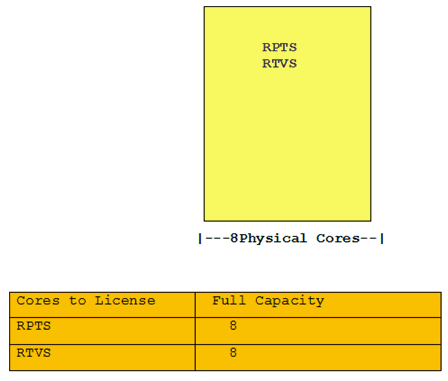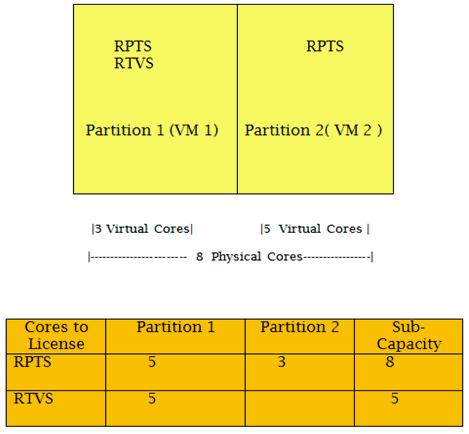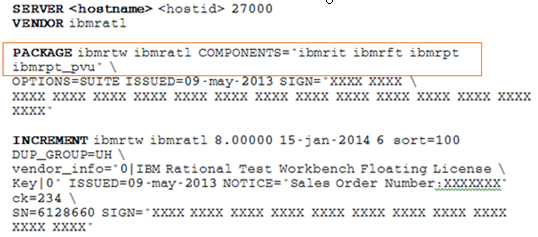White Papers
Abstract
This white paper covers different licensing aspects of IBM Green Hat products such as requirements, status output inferences, and Processor Value Unit (PVU) licenses.
Content
Author: Pankaj Sharma
Table of Contents:
Green Hat Solutions in quality management portfolio
Introduction to Processor Value Unit (PVU) licensing
Introduction to Rational Test Workbench
Introduction
With the evolution of agile methodology, application development has changed significantly. Applications are becoming increasingly complex with high level of inter-connectivity between systems, business processes and infrastructure.
In this highly challenging environment, a proactive testing approach is required to validate various modules and components to avoid late stage integration problems that can be costly to repair.
In traditional integration testing, it is complex to setup the required resources for a test environment such as hardware, application servers, and databases. It requires a great amount of "scrap and rework". Therefore, test teams require a test automation solution that can address their key technology risks and cost while enabling a holistic view of application quality.
With the inclusion of Green Hat products in the IBM Rational quality management portfolio, organizations can significantly reduce hardware, software and human resource costs required to create and maintain complex test environments.
Green Hat products virtualize software and application services. They enable developers to stand up their test environment as an when they want.
The information covered in this white paper is helpful for anyone associated with the deployment of Green Hat products. In particular, this affects Green Hat testers, Green Hat users and license administrators who handle the process and deployment of licenses in the organization.
This white paper covers different licensing aspects of Green Hat products such as license requirements, version requirements, and status output inferences. The paper also introduces you to Processor Value Unit (PVU) licenses in respect to the Green Hat portfolio.
Green Hat Solutions in quality management portfolio
With the acquisition of Green Hat, the Rational automation solution now includes these products and capabilities:
Rational Test Workbench (RTW) | Rational Performance Test Server (RPTS) | Rational Test Virtualization Server (RTVS) |
| Offer functional, integration, performance testing capabilities | Validate application scalability, simplify large scale, multi-channel workloads and resolve performance bottlenecks. | Create virtualized application environments to eliminate dependences that are blocking testing and to reduce the infrastructure costs of deploying test systems. |
| Provide the ability to stub out servers that are unavailable for testing. | Provides real-time performance reports at each stage of load testing. | Eliminates dependence on external systems or services that are affecting your test cycle. |
| Can implement continuous integration testing to help reduce the risk of errors in your application. | Prevents spending test cycles on a system that might not be delivering productive results. | Helps testers to create virtualized services or stubs to help validate their components in other areas and to test different scenarios. |
Here are the license types available for Green Hat products:
Rational Test Workbench (RTW) | Rational Performance Test Server (RPTS) | Rational Test Virtualization Server (RTVS) |
| Per Processor Value Unit (PVU) | Per Processor Value Unit (PVU) |
Introduction to Processor Value Unit (PVU) licensing
Optimization of system resources and flexible sharing of hardware is a key challenge for any organization. To use maximum system resources and get better performance, there are two widely adopted technology changes: Multi core chip technology and virtualization technologies. These two technologies push the need for Processor Value Unit (PVU) licensing. PVU is a unit used to set off licensing for Rational products such as Rational Performance Test server and Rational Test Virtualization server based on processor technology.
Number of PVU licenses required is based on these two factors:
- Processor technology - Defined within the IBM PVU table a processor for each core on a socket or chip based on these parameters:
- Processor Vendor
- Brand
- Type
- Processor Model Number
- By the Number of processor cores on a socket or chip made available to the program. For example, a quad core processor chip has four processor cores.
Advantages of PVU licenses
- PVU licenses provide a base for products like RPTS agent and RTVS agent.
- PVU offers flexible licensing where you can use single or multi processor cores based on your application workload.
Types of PVU
- Full Capacity Licensing
- Full capacity is entrenched on physical activated processor cores in the physical server. If using full capacity licensing, you must have sufficient PVU licenses to cover all activated processor cores in the physical hardware server, regardless of how the product was deployed. You are required to obtain PVU license entitlements for all activated processor cores in the server. For example, if you have a 16 processor core server out of which only eight processor cores have been activated, full capacity licensing requires you to acquire PVUs for eight activated cores.
- Sub-Capacity Licensing
- A demand for flexible licensing stems from the evolution of sophisticated server virtualization technologies that create virtual partitions and virtual servers such as VMs and LPARs. Such technology can be moved and resized in live environments. To adapt the needs of virtualization, there is sub-capacity licensing. This type allows you to license a product for less than full processor core capacity of the server when deployed in an eligible virtualization environment.
- You must use an eligible virtualization technology on a supported processor.
- You must accept the terms of the sub-capacity licensing addendum on the Passport Advantage site.
- Use the License Metric (ILMT) tool, which is used to maintain an inventory of the PVU based software deployed and measures the PVU licenses required by software products. ILMT is mandatory for Sub Capacity deployments
To be eligible for sub-capacity licensing, you must adhere to these rules:
Number of process cores with PVU
- Full Capacity
- Assume that you have RPTS agent and RTVS agent on a single server that has eight active processor cores available to these products. At that point, you must license eight cores for RPTS and eight cores for RTVS with PVU entitlements.
- Sub Capacity

- Take the example that you have two Virtual Machines or two partitions on a single server that has eight active processor cores available to RPTS agent and RTVS agent. In this case, you must license five cores in the first Virtual Machine and three cores in the second Virtual Machine for RPTS. You must also license five cores in first Virtual Machine for RTVS with PVU entitlements.

Introduction to Rational Test Workbench
RTW is a test automation solution that offers capabilities for functional, performance and integration testing. It is a collaborative platform for end to end testing. This solution includes these products:
- IBM Rational Integration Tester (RIT) is a scripting-free environment for developing tests for SOA messaging and business process integration projects. The RIT agent is included within RPTS and RTVS.
- IBM Rational Performance Tester (RPT) is a scripting-free environment for automating load and scalability testing of web, ERP, and server based software applications.
- IBM Rational Functional Tester (RFT) is an object driven automated functional testing solution for Microsoft Windows, Java, Web 2.0, and other applications.
- IBM Rational Integration Tester Platform Pack contains technology specific components used by Rational Integration Tester for recording SOA message conversations, HTTP, HTTPS and JDBC traffic. The pack also contains components for monitoring middleware systems under test with minimal reconfiguration of client applications.
- IBM Rational Test Control Panel is a server based web application that allows you to create, share, and deploy virtualized services test environments.
Understanding the RTW license file
RTW combines multiple components in to a single product with a single license file. It includes licenses for these components:
- RIT
- RPT
- RPT PVU component
- RFT
RPT, RFT, and RIT all share a single RTW license key when running concurrently on the same workbench machine. Here is a sample of such a license:

Rational Integration Tester Platform Pack and Rational Test Control Panel work as an add-on for Rational Integration Tester and do not require a license key.
Minimum version requirements to acquire RTW licenses
- RFT must be V8.2.2 or later for a RTW license key
- RPT must be V8.2.1.4 or later for a RTW license key and PVU licensing
- RPT Agent must be V8.2.1.4 to enable PVU licensing when used with RPT V8.2.1.4 or later when it is enabled for RTW.
Understanding a RTW status enquire output
You can perform a status enquiry using License Management (LMTools). The tool lists all the RTW features, included in the license file and the number of licenses available. For example:

This screen capture shows the log after the checkout of a Rational Test Workbench license key. In this case, a Rational Performance Tester is launched on the client machine.

Frequently Asked Questions
- Does RPT workbench checkout Virtual Test pack licenses?
- Virtual users running on PVU enabled RPT agents do not consume Virtual test pack licenses. It means that virtual users running on non-PVU enabled RPT agents require Virtual Test pack licenses.
- Which license checks out first for RPT workbench if the license server serves license keys for RTW and RPT concurrently?
- RPT Workbench first requests a RTW license key. If granted by license server, it enables PVU licensing for PVU enabled RPT agents. If a RTW license is not available, it requests a Rational Performance Tester license.
- Do you get only one license of RIT without the other inclusions of RTW?
- Yes, an Activation Kit serves the cause, which is exclusive to Rational Integration Tester.
- Is there a possibility you can purchase just RPTS or RTVS?
- No. You always require at least one copy of RTW to create the performance tests, and then RPTS is required to generate the load.
- How do you generate a license for IBM Green Hat products?
- Rational License Key Center hosts the license keys for Rational products. You can refer this link to know more about the steps to download licenses:
- Can Rational Performance Tester be used with the PVU licensing model?
- Yes, it can. However, there are features to be enabled with the IBM Rational Performance Tester PVU license activation kit applied. You can refer this technote for the steps on enabling RPT PVU licensing support:
http://www.ibm.com/support/docview.wss?uid=swg21611951
Conclusion
In summary, the inclusion of Green Hat solutions significantly enhances the quality management portfolio of Rational products. This white paper gives you clear description of Green Hat products and supported license types with them.
PVU licenses significantly optimize system hardware resources. The "Number of Processor Cores" section can help you in deciding PVU entitlements for Rational Performance Test server agent and Rational Test Virtualization server agent.
Rational Test Workbench RTW is an end to end test automation solution. This white paper gives you holistic overview of products grouped under RTW workbench, its license version requirements and associated frequently asked questions.
References
THE INFORMATION CONTAINED IN THIS DOCUMENT IS PROVIDED FOR INFORMATIONAL PURPOSES ONLY. WHILE EFFORTS WERE MADE TO VERIFY THE COMPLETENESS AND ACCURACY OF THE INFORMATION CONTAINED IN THIS DOCUMENT, IT IS PROVIDED "AS IS" WITHOUT WARRANTY OF ANY KIND, EXPRESS OR IMPLIED. IN ADDITION, THIS INFORMATION IS BASED ON IBM’S CURRENT PRODUCT PLANS AND STRATEGY, WHICH ARE SUBJECT TO CHANGE BY IBM WITHOUT NOTICE. IBM SHALL NOT BE RESPONSIBLE FOR ANY DAMAGES ARISING OUT OF THE USE OF, OR OTHERWISE RELATED TO, THIS DOCUMENT OR ANY OTHER DOCUMENTATION. NOTHING CONTAINED IN THIS DOCUMENT IS INTENDED TO, NOR SHALL HAVE THE EFFECT OF, CREATING ANY WARRANTIES OR REDOCUMENTS FROM IBM (OR ITS SUPPLIERS OR LICENSORS), OR ALTERING THE TERMS AND CONDITIONS OF ANY AGREEMENT OR LICENSE GOVERNING THE USE OF IBM PRODUCTS OR SOFTWARE. |
|---|
Original Publication Date
30 September 2013
Was this topic helpful?
Document Information
Modified date:
17 June 2018
UID
swg27039696